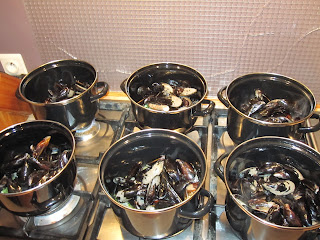This summer Ryan and I travelled to Belgium to visit his family & family friends and to do some sightseeing, but most of all, to eat. We stayed with our good friends Valerie and Marc who live just outside of Brussels. On the plane ride over I gave Ryan a crash course on useful French words and phrases like “hello,” “thank you,” and “where is the bathroom?” But when I peaked over at the vocabulary list he was generating, all he had written was “biere,” “saucisson,” “fromage,” and a list of fifty other things he planned to eat and drink on our European vacation.
Most of our itinerary revolved around finding waffle stands to hit up near Le Grand Place, locating the brasseries with the best beer selections, or finding a place where we could get our next Speculoos ice cream fix ([spek-yuh-lohs] – noun. A delicious, gingery, cinnamony, graham crackery-like cookie that can be found in ice creams and chocolates or ground up into a nutella-like paste to make other things taste more delicious). We also spent countless hours wandering the aisles of the Belgian grocery chain Delhaize picking out fresh breads, creamy cheeses, and Belgian chocolates & beer to “bring home to our friends.”
Thankfully, Valerie and Marc appreciate food just as much as we do. Valerie owns and works at a deli in downtown Brussels where she makes delicious sandwiches with fresh ingredients. According to Valerie, we (Americans) don’t have any “real” bread, milk, cheese or chocolate in this country. I don’t want to be unpatriotic, but when I thought about it I realized that most of the brands I like best are actually European: Cote D’Or chocolate or any brand of Brie cheese I buy at the store, for example. And I have to admit that the sandwich Valerie made me was one of the best sandwiches I’ve ever had (much tastier than most of the deli sandwiches I've had over here): Spanish ham with mozzarella cheese, tomato slices, olive oil, and salt & pepper on a fresh baguette.
Valerie and Marc also made us some delicious Belgian dinners during our stay: foie gras (goose liver), moules frites (mussels & fries), boudin blanc (white sausage made with breadcrumbs & cream), & lapin a la Gueuze (rabbit stewed in Gueuze beer). Most of our meals consisted of three or more courses starting with breads and salamis and inevitably ending with a cheese platter that I was always too full to eat, but accepted anyway. We were also given an endless supply of incredible French wines and Belgian beers (my favorites: Hoegaarden, Leffe Blonde, Moinette Blonde & Boon Kriek). Among one of the more decadent meals that Valerie and Marc prepared for us was foie gras stuffed ravioli in cream sauce topped with more foie gras … followed by a cheese platter.
 |
| The best cheese I've ever had! |
 |
| Foie gras ravioli |
Valerie’s philosophy on food is: “We have to enjoy every single meal because we really don’t know where we’ll be tomorrow.” Marc & Valerie certainly make sure to make every meal count. Almost every night of our visit they hosted a party of ten or more people for lunch and dinner. Their meals were drawn out for two or three hours so people could drink and visit between eating. And although Ryan and I couldn’t understand most of the conversations at the dinner table, there was something nice about not rushing through our meals. Many American families sit for about 15-20 minutes for a meal and this might be the only time they spend together throughout the day. But Marc and Valerie, and many Europeans, like to savor their food and use mealtimes to engage in good conversation. For them, eating is about socializing and enjoying life.
One of our first nights in Belgium Marc and Valerie prepared this recipe for us:
Moules, ail, crème et vin blanc (Mussels with garlic, cream and white wine)
 |
| Marc cooking mussels |
Put the butter in a big pot, chop the onion and let them cook slowly. Chop the celery and add it to the onions. Add some salt and pepper. When the onions are transparent, add the mussels (you have to rinse them several time beforehand in cold water to avoid sand). Add a glass of white wine, garlic and parsley. Cover the pot and shake the mussels so that they all mix with the vegetables. It will take only a few minutes for the mussels to be cooked. The mussels are cooked when they have all opened. A few seconds before stopping the cooking add the cream.
You can serve the mussels directly in the pot with some French fries. The best part, when you have eaten all the mussels is to drink the “mussel soup.”
You can also mix some mayo and some mustard to dip the mussels.
Bon appétit!!
 |
| Valerie and me getting ready to eat! |










